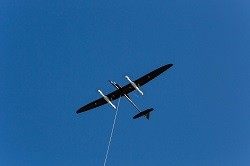New electricity-generating kite to revolutionise wind energy
Wind turbine technology has advanced significantly but it does not harness the high-energy wind that is available up high in the sky. Harnessing these high-altitude winds could meet the planet's critical energy needs and decrease the cost of power. The EU-funded project NEXTWIND (Harvesting airborne wind energy using rigid kites) rolled out technology that promises to revolutionise wind energy. This new kite-like wind turbine produces renewable energy in an environmentally friendly, safe and affordable way. The next step was to work out a plan on how to attract new investors and make the environment-friendly solution available soon enough for the commercial market. Taking wind energy to higher heights At high altitudes, the wind is much stronger and blows more steadily compared to the tip of a traditional big windmill. Project partners successfully demonstrated autonomous operation of a 30-kW kite turbine in an operational environment at their test site. This kite goes up hundreds of metres, or even a kilometre, where it can readily collect the vast amounts of energy available at these heights. Full-scale production can reach up to 1 500 metres altitude. How NEXTWIND’s kite is changing wind technology Kitemill’s new type of flying wind turbine can make wind power accessible and less expensive for many remote locations. Unlike current wind turbines, Kitemill’s kite requires no heavy designs, but instead, light structures. There are three main advantages to this kite system that makes its design better than conventional wind turbines: it reaches higher altitudes, uses less material, and is more aerodynamically effective. The system consists of the kite itself, a ground station, a control system and a vertical take-off and landing system. Integration of the latter system makes Kitemill’s kite design unique. The kite is generating an aerodynamic lift force that is transmitted into tensile forces within the rope. The rope is connected to a drum that is coupled to a ground-based generator where the electricity is generated. Finally, a control system is piloting the kite over a predefined helical flight path. The whole construction of this kite turbine requires only 10 % the mass of a conventional wind turbine and yearly operational hours can double due to operation in high altitudes. An eco-friendly and low-cost alternative to diesel NEXTWIND’s kite is making a flying leap well beyond what traditional tower-based turbines can offer. Impressive is the fact that it can produce energy at a capacity factor exceeding 50 %. What is even more important is the levelised cost of energy, a key metric of the total cost of producing energy. Given the ever-tougher carbon emissions laws, installations of renewable generation including off-grid alternatives are proceeding apace. The company Kitemill’s advanced airborne wind turbine technology can replace diesel in off-grid and weak-grid systems. Project manager Thomas Hårklau points out, “A comparison among diesel, conventional wind, and kite turbines shows how the latter can reduce the levelised cost of energy to 60 % despite the penalty of immaturity and the higher capital cost.” In addition, while conventional wind turbines require up to 10 large trucks to be relocated and need to be dismantled, kite turbines can be moved around easily and are not a permanent fixture in the landscape. This reduces the risk for stranded assets and also increases the ability to fund related projects. Kitemill’s vision is to play a significant role towards a zero-emission society. “The energy used to construct this kite-like wind turbine is far less than the energy produced during its lifetime in operation,” explains project manager Thomas Hårklau. The Airborne Wind Energy Conference held in Freiburg in 2017 was an important occasion for the industry to gather and discuss the potential of airborne wind energy systems. In this context, project partners also studied the remaining challenges to the commercialisation of this emerging energy technology with the aim of making it an attractive choice for small-scale applications.
Keywords
NEXTWIND, electricity, Kitemill, wind energy, airborne wind turbine, high-altitude winds



